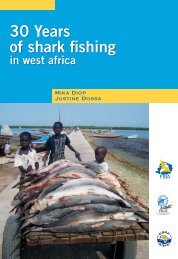Kyne & Simpfendorfer.. - Shark Specialist Group
Kyne & Simpfendorfer.. - Shark Specialist Group
Kyne & Simpfendorfer.. - Shark Specialist Group
You also want an ePaper? Increase the reach of your titles
YUMPU automatically turns print PDFs into web optimized ePapers that Google loves.
Balart et al. (2000) is 295mm TL for females and 298mm TL for males. Both Bythaelurus<br />
clevai and B. lutarius produce small litters of two (one embryo per uterus) (Compagno et al.<br />
2005).<br />
Both single and multiple oviparity can occur amongst the Galeus species, but only single<br />
oviparity is known in Apristurus, Parmaturus and Scyliorhinus (Cross 1988, Ebert et al.<br />
2006). Of the multiple oviparous sawtail sharks, G. melastomus can possess up to 13 egg<br />
cases in the uteri at one time, while G. atlanticus has been observed to carry up to nine egg<br />
cases in the uteri at one time (Muñoz-Chápuli and Perez Ortega 1985, Iglésias et al. 2002).<br />
For the oviparous Bythaelurus, only single oviparity has been observed, while Halaelurus are<br />
multiple oviparous (Compagno et al. 2005, Francis 2006).<br />
For oviparous species, estimates of fecundity are difficult as egg-laying periods and rates are<br />
mostly unknown. Ovarian fecundity may provide a proxy, but as noted previously, the<br />
relationship between the number of follicles and actual reproductive output is not clear.<br />
Castro et al. (1988) determined egg-laying rates in Scyliorhinus retifer held in captivity with<br />
pairs of egg cases laid at intervals of 14.1-16.7 days (average ~15.3 days). Taking this<br />
average and assuming continuous, year-round egg-laying activity, this would result in an<br />
annual production of 46 egg cases. This is a relatively high reproductive output for a<br />
chondrichthyan. Richardson et al. (2000) suggested that fecundity is high in H. regani, based<br />
on the proportion of mature females carrying egg cases and a continuous reproductive cycle.<br />
Fecundity in other scyliorhinids may however, be low, particularly the viviparous and<br />
multiple oviparous species, where embryos or egg cases are retained for extended periods in<br />
the uterus.<br />
Catsharks generally reproduce throughout the year, and while most species lack significant<br />
patterns of reproductive seasonality, there are often seasonal peaks in egg production. (Ebert<br />
et al. 2006). Richardson et al. (2000) suggested continuous year-round reproduction in<br />
Holohalaelurus regani with no significant difference observed in the proportion of mature<br />
females carrying egg cases between seasons, similar to the situation observed in Bythaelurus<br />
dawsoni (Francis 2006). Cross (1988) suggested that A. brunneus and P. xaniurus may be<br />
reproductively active throughout the year, although in A. brunneus more females carried egg<br />
cases in December to May than June to November. Both G. eastmani and G. nipponensis<br />
from Suruga Bay, Japan reproduced throughout the year, but with G. nipponensis showing a<br />
higher incidence of carrying egg cases in December and January (Horie and Tanaka 2000).<br />
Off southern Portugal, G. melastomus is reproductively active year-round but with bimodal<br />
peaks, in summer and winter (Costa et al. 2005).<br />
Estimates of maturity for G. melastomus have shown a high degree of consistency in the<br />
western and central Mediterranean (Tursi et al. 1993, Ungaro et al. 1997, Rey et al. 2004), but<br />
maturity appears to occur at a considerably larger size in the NE Atlantic, demonstrated by a<br />
study off Portugal (Costa et al. 2005). It should be noted that Table 2.11 provides a summary<br />
of only a handful of maturity estimations for G. melastomus from the Mediterranean and these<br />
are reviewed more comprehensively in Table 4 of Costa et al. (2005). Castro et al. (1988)<br />
suggested that there may be geographical variation in size at maturity for the chain dogfish<br />
Scyliorhinus retifer, and this was indeed supported by Sminkey and Tabit (1992) who<br />
documented smaller maturity in the northern part of the species' distribution.<br />
There is a complete lack of age and growth estimates for deepwater scyliorhinids, and the<br />
vertebrae of many species may be to poorly calcified to yield age estimates (S. Irvine pers.<br />
comm.). Tursi et al. (1993) suggested, without quantitative data, that maturity is probably<br />
reached in G. melastomus at around 3–4 years, and that maximum size corresponds to at least<br />
7–8 years. Attempts to age Apristurus brunneus, A. kampae and Parmaturus xaniurus by<br />
researchers at the Pacific <strong>Shark</strong> Research Center at Moss Landing Marine Laboratories have<br />
proved unsuccessful (B. Flammang, pers. comm.).<br />
84
















